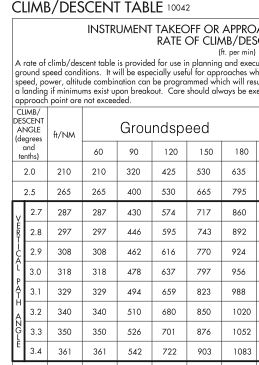Pilot Math – Descent Rate
Suppose you are flying into an airport with a VASI. When the VASI is in sight and you are descending on it, what should be your rate of descent?
AIM 2−1−2. Visual Glideslope Indicators
2. Two−bar VASI installations provide one visual glide path which is normally set at 3 degrees. Three−bar VASI installations provide two visual glide paths. The lower glide path is provided by the near and middle bars and is normally set at 3 degrees while the upper glide path, provided by the middle and far bars, is normally 1/4 degree higher. This higher glide path is intended for use only by high cockpit aircraft to provide a sufficient threshold crossing height.
One way to find out would be to go out and fly it and see what rate of descent you need for various speeds. It’s complicated somewhat because your rate of descent depends on your groundspeed—not airspeed.
The FAA includes a table on the back cover of each Terminal Procedures Publication that tells you the rate of descent or climb for various ground speeds and angles.
The part we are interested in is shown below:

If you are on a 3° VASI then you should be descending a little less than 500 fpm in most small GA aircraft. If you are in a faster plane, then a little faster.
A general rule of thumb is that for a 3 degree glideslope the descent rate is 300′ per one nautical mile (according to the table it is actually 318 fpnm). A VASI is normally visible and the descent path is protected at 4 miles so you should be at about 1200 feet above the airport when the VASI becomes visible. Steeper than 3 degrees would be a little more.
Another convenient formula is to multiply your groundspeed (or airspeed if you have nothing else) by 5 to determine the approximate rate of descent to make good a 3 degree glideslope. (You can verify this by looking at the table.)
A typical approach speed for a light airplane is 90 knots which gives about 450 fpm which is a little lower than the 478 fpm you get from the table. In any event, close enough to get you there.
Now what about on the ILS?
AIM 1−1−9. Instrument Landing System (ILS)
d. Glide Slope/Glide Path
3. The glide path projection angle is normally adjusted to 3 degrees above horizontal so that it intersects the MM at about 200 feet and the OM at about 1,400 feet above the runway elevation.
It’s usually the same. Remember that it is groundspeed—not airspeed. So if you normally fly the approach at 100 kts, your groundspeed will probably be less than that—significantly so if there is a large headwind.
In a no-wind condition, we need to interpolate to get 100kts.
(637-478) * ⅓ + 478 = 531 kts.


